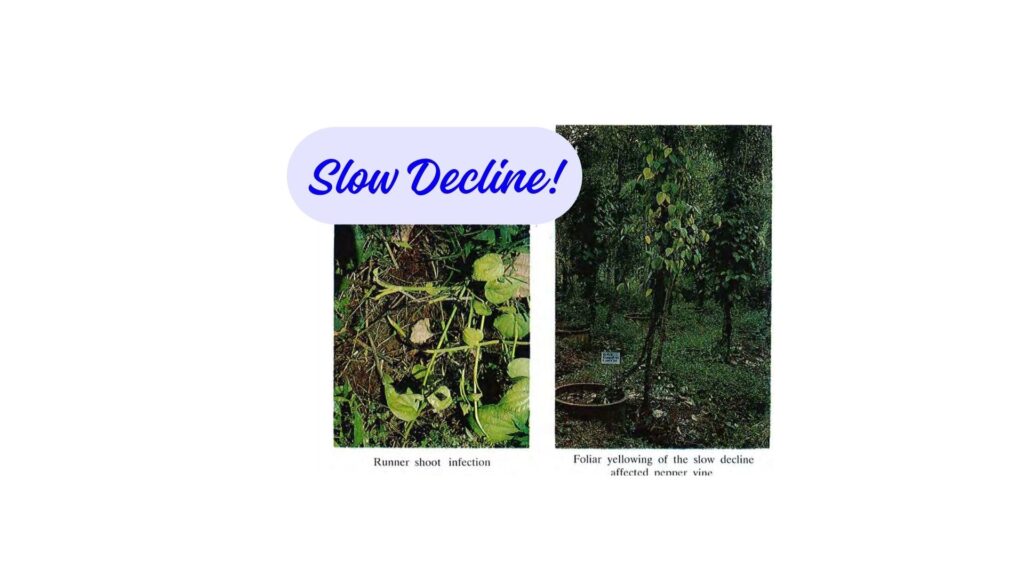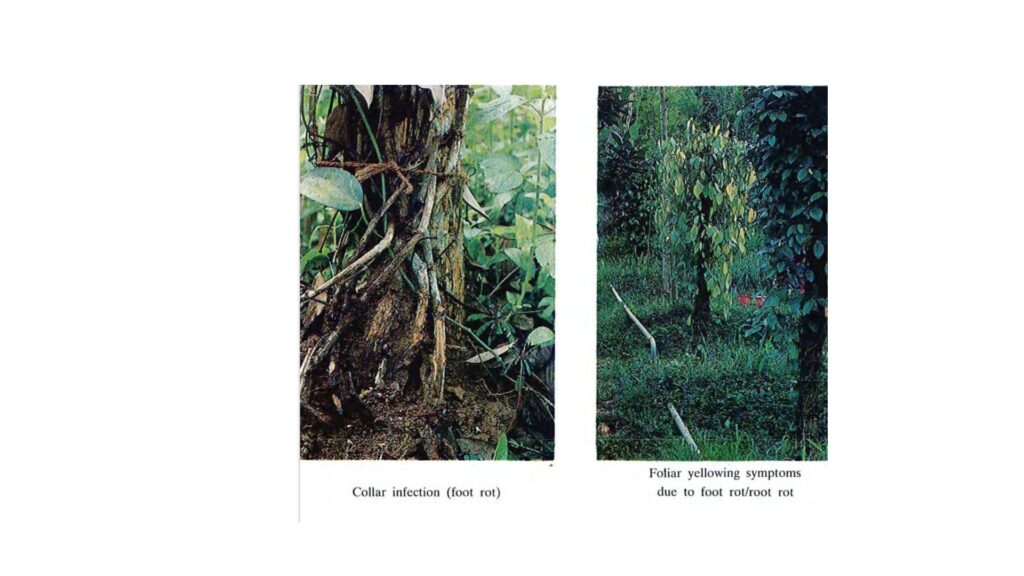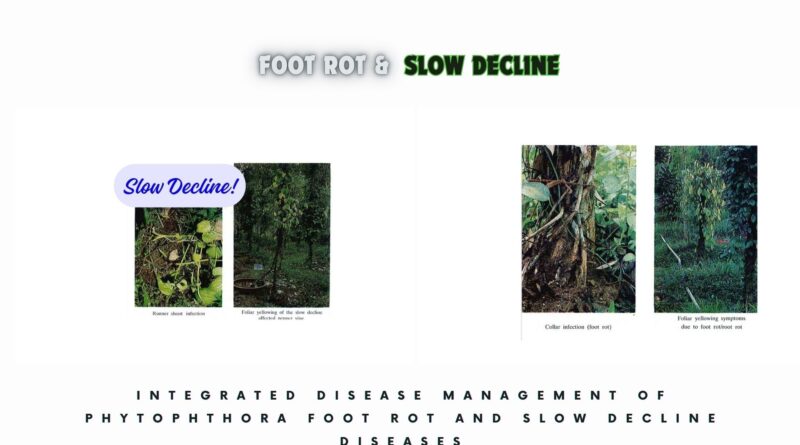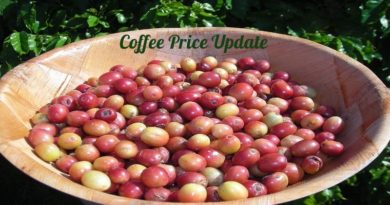Tips On Control Of Phytophthora Foot Rot And Slow Decline Diseases Of Black Pepper
PHYTOPHTHORA FOOT ROT (QUICK WILT)
This disease was known earlier as quick wilt and is caused by Phytophthora capsici, a soil borne fungus. All parts of the plant (leaves, spikes, stems and roots) are prone to infection.
Symptoms
Soil Phase: The fungus infects roots and the infection spreads from roots to collar or the foot (stem region at the ground level) of the bush. Collar infection is fatal. It also occurs through the infected runner shoots. The root infection starts during May-June with build up of soil moisture and continues as long as soil moisture is high and temperature below 30°C. The affected plants in early stages of infection show foliar yellowing of different intensities. In advanced stages, the leaves drop off, aerial branches break off at the nodes and finally the vine dies. Occasionally the vine dies without showing any foliar yellowing. The disease spreads through soil water and root contact.

Aerial Phase: The fungus also infects leaves causing dark brown spots (lesions) which enlarge rapidly covering major portion of the leaf. The lesions show characteristic fimbriate margins. Occasionally concentric zonation of the spots with pale whitish centre is also noticed. Infected leaves drop-off and thus foliar infection leads to varying degrees of defoliation. When infection occurs on the branches, the infected branches turn dark brown due to rotting. Branches, beyond the point of infection, show foliar yellowing, defoliation and wilting. Fungus also infects spikes at any point causing rotting and the affected spikes drop off. Foliar infection occurs during June-July period coinciding with heavy rainfall. Disease spreads from lower regions of thebushto upper parts through rain splashes.
SLOW DECLINE
Slow decline infection causes varying degrees of foliar yellowing and defoliation. This was earlier known as slow wilt. It is a debilitating disease complex caused by feeder root infection by Radopholus similis and Meloidogyne incognita, two important soil borne plant parasitic nematodes. Independent infection of roots by P. capsici and nematodes also might occur. This association varies from place to place.
ROOT ROT
The damage to the root caused by these nematodes combined with Phytophthora weakens the root system resulting in varying degrees of root rot and leads to foliar yellowing. Affected vines gradually decline in vigour and productivity. The disease affected vines with degenerating root system exhibit intense foliar yellowing from January onwards with gradual depletion of soil moisture. The vines with severe root infections dry up during this period.

INTEGRATED DISEASE MANAGEMENT OF PHYTOPHTHORA FOOT ROT AND SLOW DECLINE DISEASES
Since P. capsici and plant parasitic nematodes are soil borne and also inseparable in the natural ecosystem in majority of the cases, it is important to suppress these pathogens to boost up vigour and productivity of the vine.
Cultural Practices
- Phytosanitation: Remove infected and dead vines along with root system from the plantation and burn to check the population build up of these pathogens.Drench the spot with 5 lit. of copper oxychloride (0.2%).
- Provide good drainage in the plantation where the plantation is prone for water stagnation.
- Maintain legume or grass cover in plantations during rainy season to reduce soil splash and consequent foliar infection.
- Lop off branches of live standards during May to ensure better light penetration and to reduce humidity build up in the plantation.
- Prune off tender runner shoots/leaves and hanging shoots which are touching the soil or tie them to the standard to reduce the chances of infection
- Practice minimum tillage concept to avoid injury to root system.
- Avoid frequent movement of personnel from diseased garden to healthy garden.
- Replant atleast one year after the removal of the dead vine. Plant disease free rooted cuttings: in the pits. Burn dry trash in the pits and also drench with
0.2% copper oxychloride 15 days prior to planting.
Biocontrol
- Apply neem oil cake as a soil amendment @ 1 kg/ vine during May—June, which has a suppressive action both on nematodes and Phytophthora, apart from its source as nutrient.
Chemical Control
- Spray vines with Bordeaux mixture (1%), drench the basins with 3—S litres of (0.2%) copper oxychloride (2g/lit) or 1% bordeaux mixture, once as a pre-monsoon treatment (May—June) and again as a post- monsoon treatment (August—September). The quan- tity of copper oxychloride depends upon size of canopy. Apply Bordeaux paste upto 30 cm from base to check collar infection.
- Spray the vines with Ridomil—Ziram (2.5 ml/l) or Ridomil – MZ 72 WP (1.25g/l) and also drench the bascof the vines @ 5 lit./vine by skipping one of the above bordeaux mixture treatments.
- A third round of soil drenching with copper oxy- chloride/bordeaux mixture can be given during October, if north-east monsoon continues. Fork in 30g of phorate (Thimet 10G) to the soil around the vine during May-June and repeat the same during August-September to check nematodes.
PRECAUTIONS
- Mild foliar yellowing is an indication of root infection and needs a careful watch and prompt phytosanitary and prophylactic action.
- Presence of runner root infection or leaf infection is a warning signal to note that Phytophthora is active.
- Timely application of fungicide/nematicide is important and application at advanced stages of infection would be ineffective. Optimum time differs from place to place depending on the earliness of monsoon showers.
- Resort to foliar spray at maximum foliage emergence.
- Adequate soil moisture should be ensured at the time of nematicide application.
- Avoid using runner shoots from diseased gardens as planting materials.
- Neem oil cake with oil content of atleast 3—4% should be used as a soil amendment and the solvent extracted cake will not be effective.



